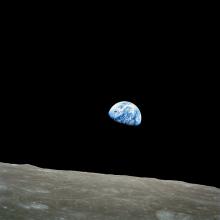Listen to today's episode of StarDate on the web the same day it airs in high-quality streaming audio without any extra ads or announcements. Choose a $8 one-month pass, or listen every day for a year for just $30.
You are here
On the Move
As you listen to this program, you may be sitting still at your desk, or perhaps whisking down the highway at 70 miles an hour in your car. But those feelings of motion — or lack of it — are misleading. We’re all zipping through space at a couple of million miles per hour — the combined result of several different motions.
The most obvious of those motions is Earth’s rotation on its axis. It takes a bit less than 24 hours to complete one full turn. So anyone at the equator is moving at more than a thousand miles per hour. Those of us in the United States are moving a bit slower than that, since Earth’s circumference at higher latitudes is smaller than at the equator.
The next motion is Earth’s year-long orbit around the Sun, which we complete at an average speed of about 67,000 miles per hour.
These motions are small, though, compared to what comes next. The entire solar system is orbiting the center of the Milky Way galaxy, which is about 27,000 light-years away, at half a million miles per hour. Even at that speed, though, it takes about 230 million years to complete a single turn around the galaxy.
Finally, the entire Milky Way is moving toward a giant cluster of galaxies in the constellation Virgo, as well as a supercluster of galaxies beyond it. The gravitational pull of these great clusters accelerates us to about 1.3 million miles per hour — a high-speed jaunt across the universe.
Tomorrow: some of the Milky Way’s most ancient stars.
Script by Damond Benningfield





